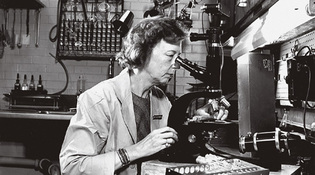
March of Dimes
Researcher Dorothy Horstmann proved that the polio virus reaches the central nervous system via the blood, a discovery crucial to the development of the polio vaccine.
View full image
Two centuries ago, Connecticut chartered a medical school at Yale. Ever since, through lean times and good times, the school has been training future doctors and, especially in its second century, performing signal medical research.
For this modest selection of highlights, we've drawn from many sources. Not all of Yale University's contributions to medical science appear here, because not all took place at the medical school; for instance, it was a zoology professor and a postdoc who helped launch the era of genetic testing in 1980 by producing the first strain of transgenic mice. Nor can all of the medical school's own history, scientific or otherwise, be compressed into one magazine article.
You can read more in the new official history, Medicine at Yale,by Kerry Falvey. Or you can attend one of the 2010–11 bicentennial events listed on the school's website. If you do, read this timeline first: it should get you through a cocktail party or two.
1806
Yale's board of trustees resolves that Yale should hire a professor of medicine. This obvious step toward establishing a medical school attracts the keen interest of the Connecticut Medical Society, which up until now has enjoyed a monopoly on granting medical degrees in the state. Extended negotiations begin.
1810
Yale and the medical society agree on terms for a joint venture. The medical school, sixth in the country, is chartered by the Connecticut legislature.
1813
The school opens for business, with 37 students. Its five professors range from the nationally known chemist Benjamin Silliman '96 to the Connecticut physician Eneas Munson '53, an alchemist by hobby. (Munson, 79, evidently has an honorary post; he will never actually do any teaching.)
1824
A West Haven farmer discovers that the grave of his 19-year-old daughter is empty. He demands to search the medical school and finds her body hidden in the cellar. Rumors were already circulating in town that medical students had dug a tunnel from the school to the Grove Street Cemetery across the street, and the news of the grave robbery sparks a week-long riot, town against gown. Eventually, the state legislature will ease the severe shortage of cadavers for medical schools by permitting dissection of the bodies of executed criminals.
1835
The school starts optional spring and summer demonstration courses—unusual in an era when most medical schools attracted students by offering lecture classes and low standards, and medical societies (including Connecticut's) granted licenses to students who had just a year of medical instruction.
1839
Yale requires all MD candidates to complete a thesis demonstrating wide reading in medical literature. Except for a brief hiatus, the thesis requirement will remain in place. (Today, students must do original research.)
1857
Cortlandt Van Rensselaer Creed earns his Yale MD, becoming the first African American to receive a Yale degree. (The first African American to earn a U.S. MD received his in 1847 from Rush Medical College.) Creed will set up a successful practice in New Haven and later serve in the Civil War as acting surgeon of the Thirtieth Connecticut Colored Regiment.
1873
The medical faculty complains to Yale's trustees that the school is in "critical condition" due to inadequate funding. Professors are reduced to covering expenses out of their own pockets.
1879
Yale starts requiring medical school applicants who lack college degrees to take an entrance exam. (The only other school in the northeast to do so is Harvard.) With the entering class of 1881, new enrollment drops to its lowest point ever: 21 students.
1901
William H. Welch '70, first dean of the preeminent Johns Hopkins medical school, is asked to speak at Yale on "the relation of Yale to medicine." He complains in a letter to his sister: "If they had only asked me to talk on the relation of Yale to Calvinism or football there would be something to say." In the talk, he will urge the university to provide more funding.
1910
A Carnegie Foundation investigator evaluates 155 U.S. medical schools and deems only 31 worth keeping. Yale's and Harvard's are among them, the only two in the northeast. But the report delivers a withering assessment of Yale: although the medical school requires entering students to have at least two years of college, it does not "deserve the higher-grade student body" because, as with many U.S. medical schools, its curriculum is more suited to high school graduates. The report calls for "larger permanent endowment." Yale begins to raise more money for the school.
1913
Yale and New Haven Hospital (now Yale–New Haven Hospital) agree to collaborate on turning the hospital into Yale's primary teaching hospital.
1915
The school's Department of Public Health is founded.
1916
Sixty-seven years after New York's Geneva Medical College granted the first U.S. MD for a woman, three women—Louise Farnam, Helen May Scoville, and Lillian Lydia Nye—are admitted to Yale School of Medicine. (Their admission is contingent on Farnam's father donating $1,000 for a women's bathroom.) Farnam will graduate first in her class and later teach and practice for ten years in China.
 loading
loading